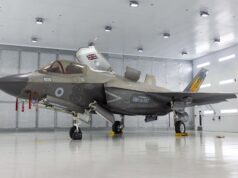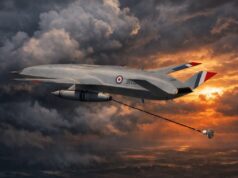The UK government is exploring the possibility of repurposing decommissioned military equipment for use by Ukraine, Defence Secretary John Healey revealed in Parliament.
Responding to questions from Defence Committee Chair Tanmanjeet Singh Dhesi, Healey stated that no final decisions have yet been made regarding the retired assets.
Addressing the Commons, Healey emphasised that the recent retirement of ageing platforms, including HMS Northumberland and the Watchkeeper drones, was necessary to modernise the UK’s Armed Forces.
“The decisions I have taken help us to get a grip of the MOD budget now and create greater scope to better implement the strategic defence review when it reports,” he explained.
Dhesi welcomed the announcement of overdue reforms but questioned the potential for transferring decommissioned equipment to allies or Ukraine.
“First, will the unrequired kit be either sold to allies or given to Ukraine? Secondly, how will our people be reskilled and retrained, so that there are no job losses?” he asked.
Healey assured Parliament that personnel would be retrained or redeployed, with no job losses expected. On the future of the retired equipment, he said: “Further decisions about what to do with the decommissioned equipment have not yet been made, but when I make those decisions, I will ensure that I inform my hon. Friend’s Committee.”
Healey also took the opportunity to reiterate the government’s commitment to addressing longstanding financial pressures in defence, noting that difficult decisions were required to ensure the Armed Forces remain ready for future challenges.
At the UK Defence Journal, we aim to deliver accurate and timely news on defence matters. We rely on the support of readers like you to maintain our independence and high-quality journalism. Please consider making a one-off donation to help us continue our work. Click here to donate. Thank you for your support!













It seems the chinooks that are being removed from service are 35 years old. After seeing 3 Chinooks out of service after an exercise due to mechanical faults, I we think need some new ones. One was still at the airfield half a week needing its gearbox fixed. Props to the guys who had no facilities and had to do it out on the stand.
The Chinook Fleet is undergoing a rolling replacement programme – 14 life expired ones going OOS and 14 new ones coming in.
I do remember seeing an article about purchase of a few chinooks while ago.
It’s 14 going with 9 new Chinook-ER replacing them, the 9 arriving will take over the SF role as they are effectively MH-47G.
Total fleet size will be 51 once the changes occur.
The thing is when you stretch maintenance intervals to the max to keep costs down then things break particularly on older frames where everything is so very worn. That is just statistics. I’d hope that approach wasn’t taken to safety critical components….
So true across the board as we saw with Nimrod and that cost lives in the end. T23’s should have been replaced many years ago but they are now falling apart and other assets better used. Both LPD’s were never really an asset as no hanger for the Helo’s and the basic crews far too large. Shoudl have been used better when at sea. MOD has a much to answer for for the state of the MOD. We should not be robbing perfectly goof fighters to keep others going when the spares etc should be on the slelves ready for when needed.
The LPDs were a great asset. They are in excellent condition, each having spent a large part of their life in refit. The crews are large (the real reason why they’re underused and being decommissioned) They are many times more useful and capable than the RFA LPD(A) and being built to naval rather than merchant standards safer. They can act as fleet flagships and also provide an extensive ISTAR capability that is now lost.
I can tell you for a fact that no Chinook aircraft servicing intervals are ever “stretched” to save costs. I know this because I worked in the Chinook Aircraft Servicing Flight for 12 years. If an aircraft goes U/S in a field or somewhere then it needs to be correctly repaired before flight, that can take time. The only original part of the old Chinooks in the RAF is the actual fuselage, everything else is maintained as required by the MOD and Boeing. It’s also the same for the Pumas.
Replacement of old kit is a necessity for sure and the new Chinooks will simply replace well worn airframes. The NMH may or may not go ahead (partly replaced by new H145’s ordered for which the SF will also get as a more suitable fit than larger Helo’s) as the numbers are so low hardly worth building them in the UK at a much higher cost than getting them off the shelf (money spent on the PUMA would have been better spent on the Sea King a much more capable airframe with plenty of spares in house). And pass them to those that need them the ARMY. The rest well the past record is we give away a lot of kit then the next day actually need it. Bigger reserves would be the way forward for both the RAF and Army to give it actual war fighting mass.
Yes, classic case was the Shorts Belfast “cut” around 1975 and come the Falklands in 1982 the civil operator was maxed out’.
Allegedly the cost to rent the Shorts Belfast from HeavyLift for the flights to the Ascensions, Gibraltar etc was far greater than the cost of operating them from the 70’s past 1982….
As far as I know the service intervals have stayed the same on items such as the drive train/gearboxes for the last 10 years. This is even with the advent of a health and usage monitoring system (HUMS) that was incorporated in to the fleet. The gearboxes in particular go through several in depth inspections, where the internals are reconditioned or replaced.
The mechanical side of things on the Chinook are fine. It’s the airframes that are buggered. Although the frames don’t have a fatigue life like fixed wing aircraft. The constant vibration does cause a lot of skin panting, rivet loosening and frame cracking. The early Mk1 Chinooks have frames made up of bonded and riveted pieces. Whilst the newer ones have frames milled from one piece stock. This makes them much more rigid, but does mean the cracks now appear in different places. Sadly it’s inevitable due to the aircraft’s design.
“Retired”
If the Tories had cut these aircraft it would be called for what it is. A CUT.
Where is FMH, and when will it be in service?
And how long for the 14 new Chinooks?
Assuming both survive the SDR.